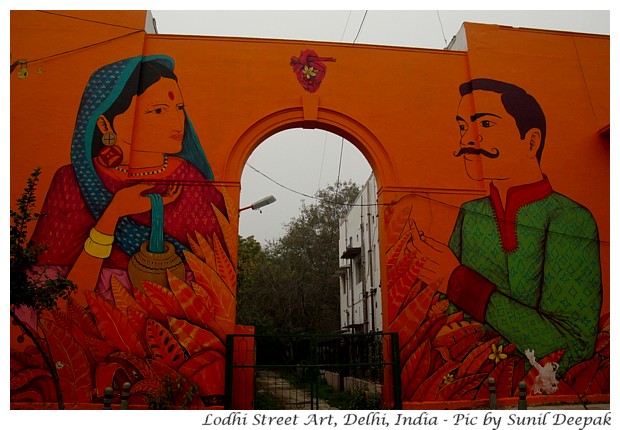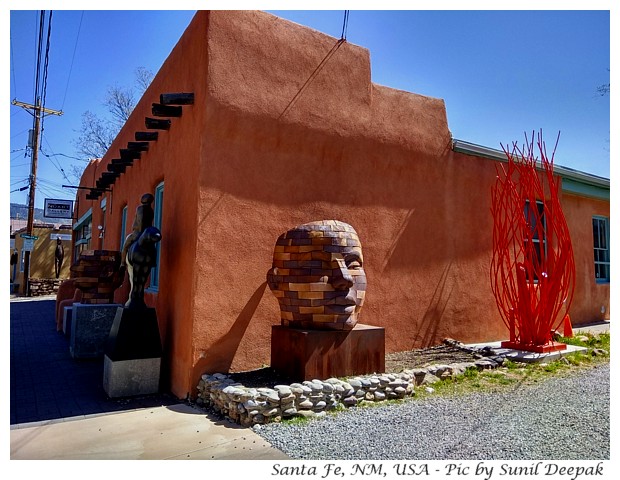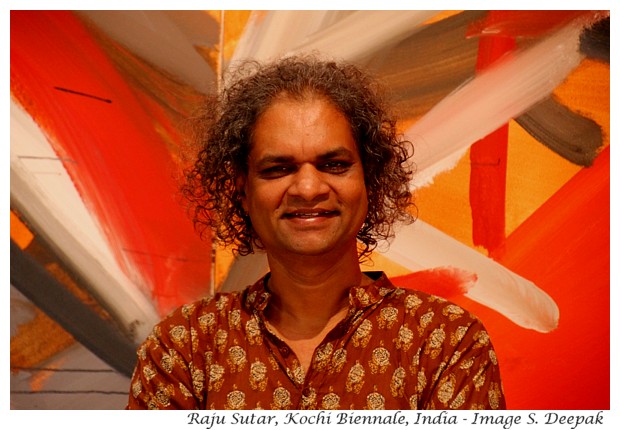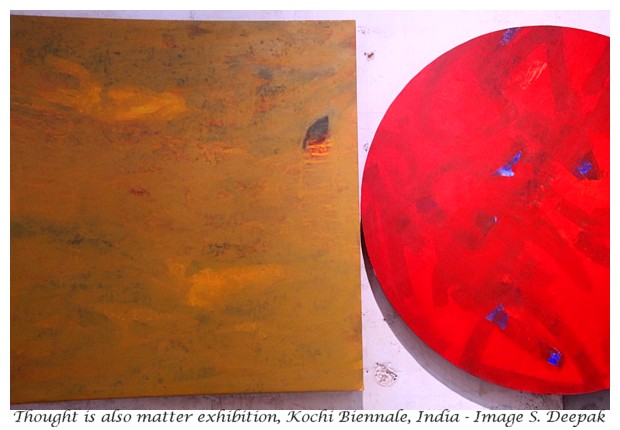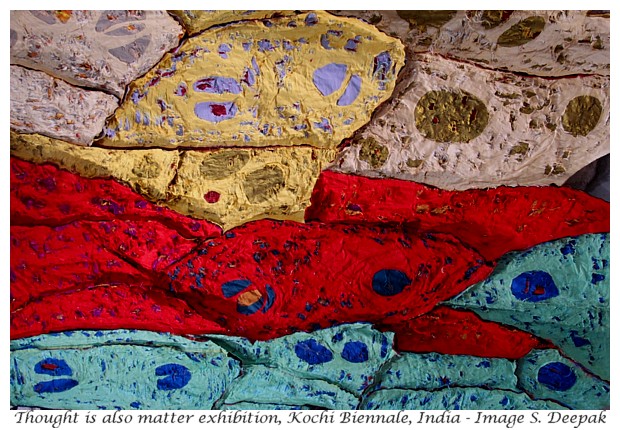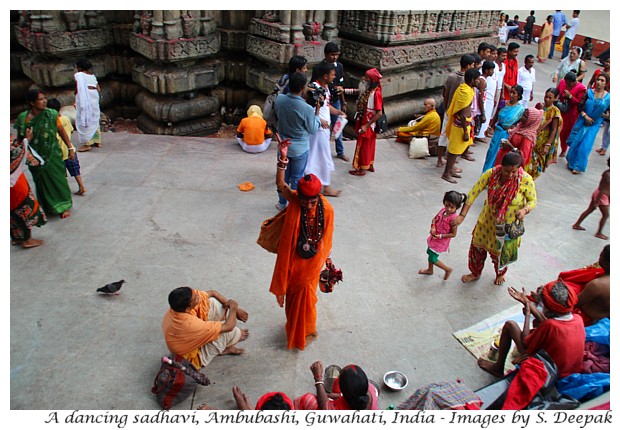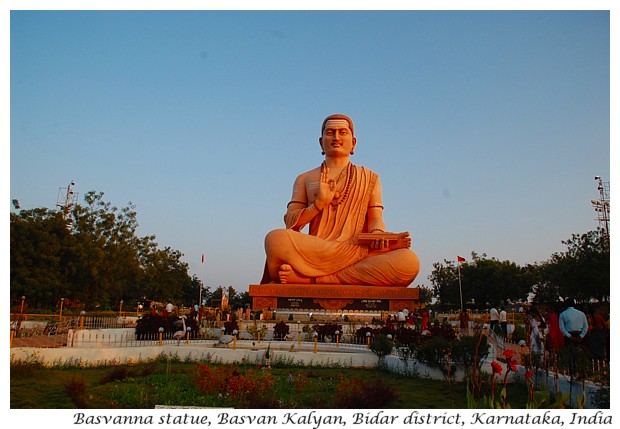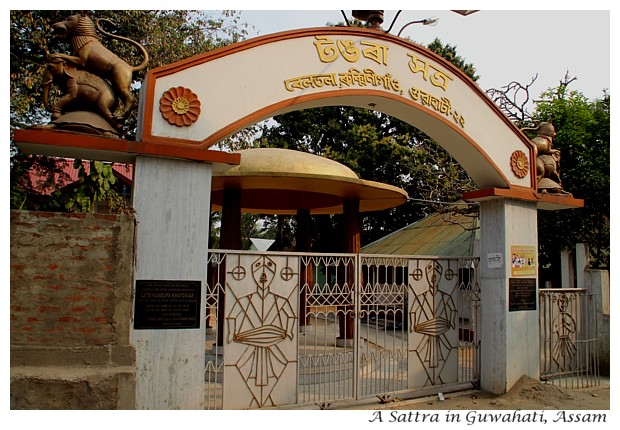In this post I have chosen 3 cities from Italy (Dozza, Caorle and Burano), 1 city from Greece (Mykonos), 2 cities from India (Lodhi Colony/Delhi and Fort Kochi) and 1 city from USA (Santa Fe/New Mexico) - as cities that have made an interesting use of colours and art in the city life. Let me start with Santa Fe.
Here, you can see open air installations, sculptures, paintings, and all kinds of artistic expressions in all the possible styles, from modern and post-modern to abstract, figurative, conceptual, material, western and traditional Amerindian.
Santa Fe – USA
Santa Fe in New Mexico is a beautiful city with some amazing museums. With its typical houses built with adobe, you can breathe art in its air. The reason why I have included it in this post is because of a place called Canyon street, which is less than 1 mile long and has about 100 art galleries and artists’ studios.Here, you can see open air installations, sculptures, paintings, and all kinds of artistic expressions in all the possible styles, from modern and post-modern to abstract, figurative, conceptual, material, western and traditional Amerindian.
Apart from Canyon street, even the city centre has some wonderful art galleries. If you go out in the surroundings, you can discover other artists’ studios and art galleries. We had an amazing time in a small village called Truchas, where the owner of the Hand Arts gallery, William A. Franke, accompanied us in a discovery of the works of some local artists like William Maxon.
Yet, every time I think of Santa Fe, I remember the afternoon spent walking from one art gallery to another on the Canyon Street, feeling drunk with the beauty of all the different art works.
Yet, every time I think of Santa Fe, I remember the afternoon spent walking from one art gallery to another on the Canyon Street, feeling drunk with the beauty of all the different art works.
Fort Kochi – India
Fort Kochi is a small island connected to Kochi-Ernakulam towns on the mainland in Kerala in south of India. Centre of the spice trade with communities from different parts of India settling here since ancient times, from 17th to 20th century, this place was under Dutch, Portuguese and British rules. Thus, the tiny and densely populated island is dotted with streets and buildings that show a mixing of traditional with the different colonial influences. With the decline in its importance as a trading centre, many of the old colonial buildings are abandoned, leading to a characteristic ambience where memories, nostalgia and decay intermingle with lush tropical greens and blue of the sea.
For past couple of decades, Fort Kochi was one of the haunts of the European tourists, who came to stay here in the old houses converted into simple bed-n-breakfast places. In 2012, the first art biennale was held here. In the past 6-7 years, the Biennale has transformed the sleepy island, as every two years, for 3 months, many of its old buildings and abandoned warehouses are taken over as sites of art installations.
I have visited the art biennale in Kochi twice and every time I come back with amazing memories of some great art works that have an extra dimension to them because they are scattered among the decaying and abandoned old buildings and warehouses.
I have visited the art biennale in Kochi twice and every time I come back with amazing memories of some great art works that have an extra dimension to them because they are scattered among the decaying and abandoned old buildings and warehouses.
In Fort Kochi, the sea, the lush vegetation, the memories, the history and the nostalgia, are all one with the art. However, its success may lead to its undoing. As Fort Kochi attracts more visitors, the old colonial houses are being replaced by multi-story concrete buildings.
Earlier this year, I was sad to see many changes - the old vegetarian restaurant near the bus stand replaced by a swanky juice and burger joint, the quaint place where I had stayed a few years ago now had a new multi-story building and the bus service which connected Fort Kochi to Munnar had been cancelled. I am keeping my fingers crossed but to be honest, I am worried that soon much of the central part of old Fort Kochi will be gone forever.
This island was already a holiday destination in the pre-second World war period. However, it became famous as a tourist hotspot of the rich and famous in 1960-70s. Traditionally, the houses here were always painted white to protect them from the harsh sunlight.
Earlier this year, I was sad to see many changes - the old vegetarian restaurant near the bus stand replaced by a swanky juice and burger joint, the quaint place where I had stayed a few years ago now had a new multi-story building and the bus service which connected Fort Kochi to Munnar had been cancelled. I am keeping my fingers crossed but to be honest, I am worried that soon much of the central part of old Fort Kochi will be gone forever.
Mykonos, Greece
Mykonos in the Aegean Sea off the Greek coast is the second island in my list. It is also the only one where the dominant colour is white, which gives its characteristic ambience.This island was already a holiday destination in the pre-second World war period. However, it became famous as a tourist hotspot of the rich and famous in 1960-70s. Traditionally, the houses here were always painted white to protect them from the harsh sunlight.
The white houses of Mykonos with their blue window shutters and church domes make for a striking effect.
Burano, Italy
Burano is the third and last island on my list – actually it is a group of 4 interconnected islands, part of Venice town in the north-east of Italy. It was famous for its delicate crocheted lace.
Burano is also famous for its houses painted in all the colours of the rainbow. Its narrow venetian streets, reflected in the waters of the canals, make for incredibly picturesque views.
Burano is also famous for its houses painted in all the colours of the rainbow. Its narrow venetian streets, reflected in the waters of the canals, make for incredibly picturesque views.
While looking for the history of Burano, I found that its houses have been painted like this in different colours since old times. The place is magical and if you are visiting Venice, do not miss visiting Burano.
Caorle – Italy
From the islands, now we move to the seaside. The tiny town of Caorle, north of Venice, also has brightly painted colourful houses just like Burano, but that is not why I have included it in my list.
Its link to the art is in boulders that line part of its seaside. Every year, the city invites some sculptors to carve a sculpture on a boulder (image below).
Its link to the art is in boulders that line part of its seaside. Every year, the city invites some sculptors to carve a sculpture on a boulder (image below).
In this way, a walk on the path close to the boulders, becomes an opportunity to admire open-air sculptures of artists from around the world.
The last two cities in this list are examples of urban street art projects.
Lodhi Colony, Delhi, India
Lodhi Colony is a residential area in central Delhi, close to some urban land marks that are well known to the tourists including the Lodhi Gardens, India Habitat Centre and Safdarjung tomb. Using the walls of this residential colony to make street art by well known artists from around the world started in 2014.The third edition of Lodhi Street Art festival, during which artists from India and other countries were invited to make new street art was completed recently in 2019.
I feel that the beautiful colours and the different artistic styles have transformed this drab and monotonous looking area into something more vibrant and joyful. Walking around the streets of Lodhi Colony, you can see an open-air art exhibition.
I feel that the beautiful colours and the different artistic styles have transformed this drab and monotonous looking area into something more vibrant and joyful. Walking around the streets of Lodhi Colony, you can see an open-air art exhibition.
Let me share a local secret - if you are visiting the Lodhi Street Art project, keep your eyes open for the street vendor next to a park in Block 10. It is usually crowded with visitors – this is Chidambaram’s Dosa place, one of the best places in Delhi to get south Indian food. There is no place to sit and it may not look very impressive, but the food will have you licking your fingers and it costs little.
Dozza – Italy
The tiny medieval town of Dozza located on a hill, not very far from Bologna in northern Italy, was one of the first towns to use street art to bring visitors. After the second world war, young persons from small towns had started migrating to the nearby bigger cities and medieval towns were often left with elderly persons. In the 1970s, the town decided to invite every year a few artists from Italy and other countries to come and paint on the houses of the old walled city.Dozza has a little medieval castle and is surrounded by gently rolling hills covered with vineyards. This is the area of San Giovese wines. Visitors coming to the see the painted town can also visit the castle, buy local wines and perhaps eat at one of the characteristic restaurants.
While Dozza is beautiful, its limitation is that the old walled city is small and almost all its houses are already covered with paintings. Unless the paintings keep on renovating, I guess local persons from surrounding areas may not come here frequently. Fortunately, the smaller towns located around big cities have had a renaissance – young people who had migrated to bigger cities, are coming back because of higher quality of life in smaller towns.
I believe that as countries around the world reduce poverty and develop, and the coming 4th industrial revolution based on artificial intelligence, nanotechnologies and biotechnologies takes off, increasingly we are going to look at places which offer better quality of life – less pollution, historical roots, natural beauty and cultural opportunities. Cities which choose colours and art, add an extra dimension of joy to our lives.
Conclusions
I hope that you have had as much fun reading about the cities of colour and art as I had in writing this post. It gave me an opportunity to think back to some travels, go through old pictures and relive the joys of those journeys.I believe that as countries around the world reduce poverty and develop, and the coming 4th industrial revolution based on artificial intelligence, nanotechnologies and biotechnologies takes off, increasingly we are going to look at places which offer better quality of life – less pollution, historical roots, natural beauty and cultural opportunities. Cities which choose colours and art, add an extra dimension of joy to our lives.
As the cities I have chosen for this post show, it is not enough to have one innovative idea, but you need to nurture it and keep on innovating. At the same time, when tourists do come, we need to make sure that the essential characteristics and heritage of our cities are not destroyed because of commercial greed.
*****
#urbanrenewal #citiesofcolour #citiesofart #usa #italy #greece #india #kochibiennale #dozzaitaly #santafeusa #mykonosgreece #lodhicolonystreetart













